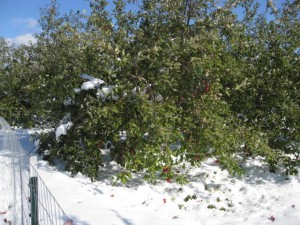A freak snowstorm dumped over a foot of snow on Central Massachusetts yesterday. I saw the flakes coming down fast and furious in the late afternoon, and then, shortly after 7 pm, the power went out. We are still in the dark here, and without electricity, I’m cut off from the world. But because I cook and heat with natural gas, I’m better off than most folks. I’m clean and warm and well-fed, though I still find it disconcerting to wash dishes by feel and put on makeup without being able to see my face.
When the sun came out in the early afternoon, I went out for a walk. Here are some of the images from around the neighborhood that I captured with my camera:
[Update on Nov 2: Power was restored to my home shortly after 6 am this morning. I’ve compiled a few stats about the storm, courtesy of weather.com.
- Worcester, MA – 11.4″ (Storm total: 14.6″) on Saturday beats the previous single day record snow total in October of 7.5″ set on October 10, 1979
- Peru, MA (one of the Hilltowns) – Received 32″, which is the biggest snow total from this storm as of early Sunday morning
- At the storm’s height, at least three million customers lost electric power
Here is what weather historian Christopher C Burt posted about the storm on wunderground.com: “The most extraordinary October snowstorm in over two centuries in the Northeast U.S. has finally come to an end this Sunday afternoon. Not since the infamous snow hurricane of 1804 have such prodigious amounts of snow been recorded in New England and, to a lesser extent, in the mid-Atlantic states. In fact, the snowfall, in most cases, has exceeded that of even the great October snow of 1804.”]










